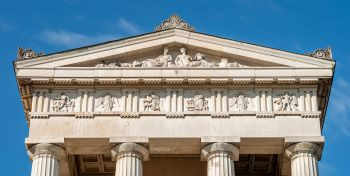


At an impressive 18 metres high, the Bavaria towers over Munich as the patron saint of Bavaria on the edge of the Theresienwiese. The Bavarian King Ludwig I commissioned the monumental statue in 1837. As the first colossal bronze sculpture in modern times, the casting of Bavaria is considered one of the technical masterpieces of the 19th century. It stands on a base 8.92 metres high and measures a total of 18.52 metres from the base to the raised oak wreath. What makes it so special is that the Bavaria is the only large bronze in Germany that can be walked on. In its cavity, you can climb up a steep spiral staircase to a viewing platform at the top. The patron saint is framed by the Hall of Fame, in which busts of important Bavarians from the past centuries are exhibited. As a patriotic monument, the ensemble was intended to commemorate the merits and glory of Bavaria.

Clickhere
to see on google maps
Address:
Theresienwiese, Theresienhöhe 16, 80339 Munich
Your ticket to visit the Hall of Fame and the Bavaria is already included in your Munich City Pass. For this attraction you get a discount of 1 Euro / ticket with the Munich Card